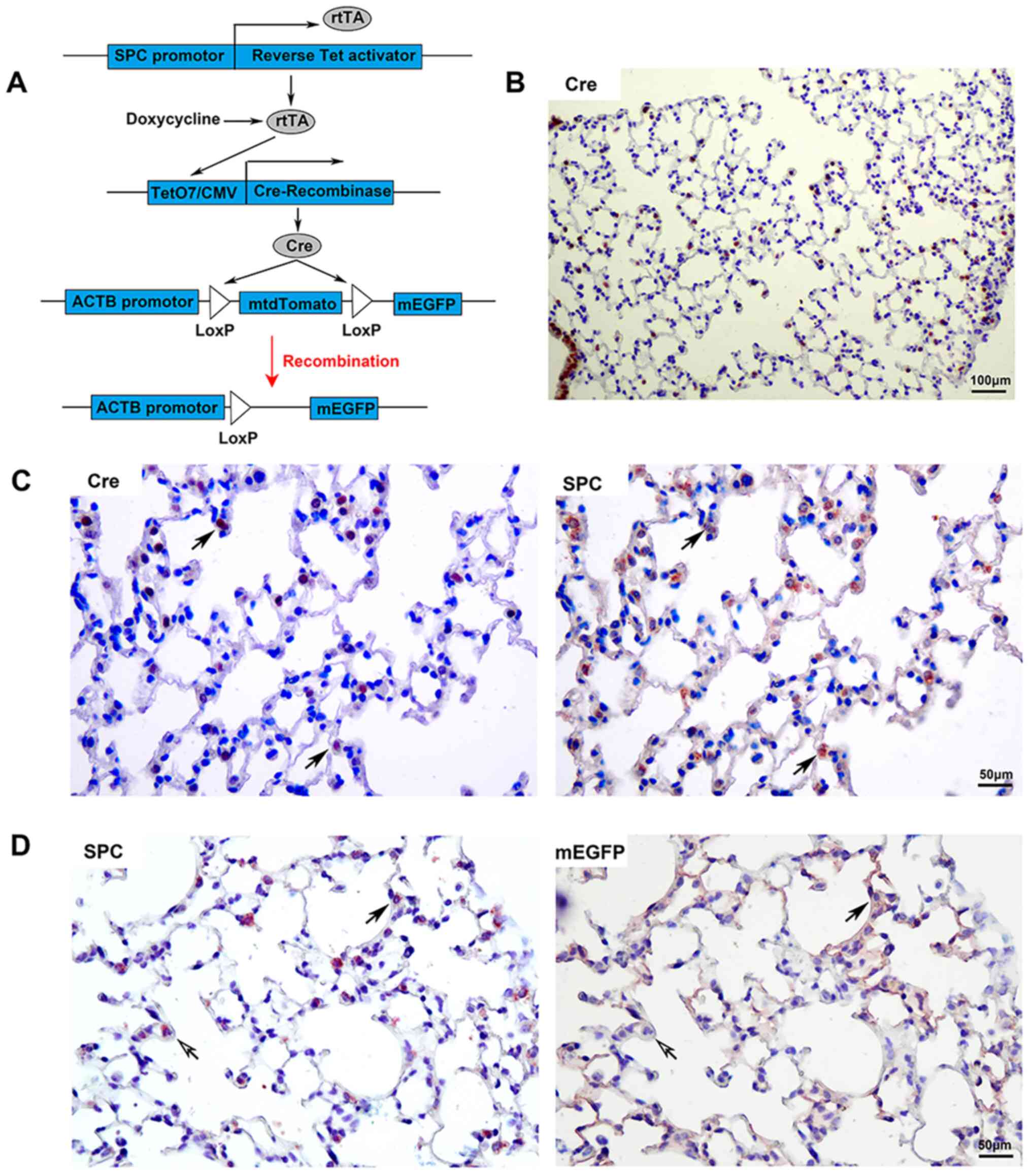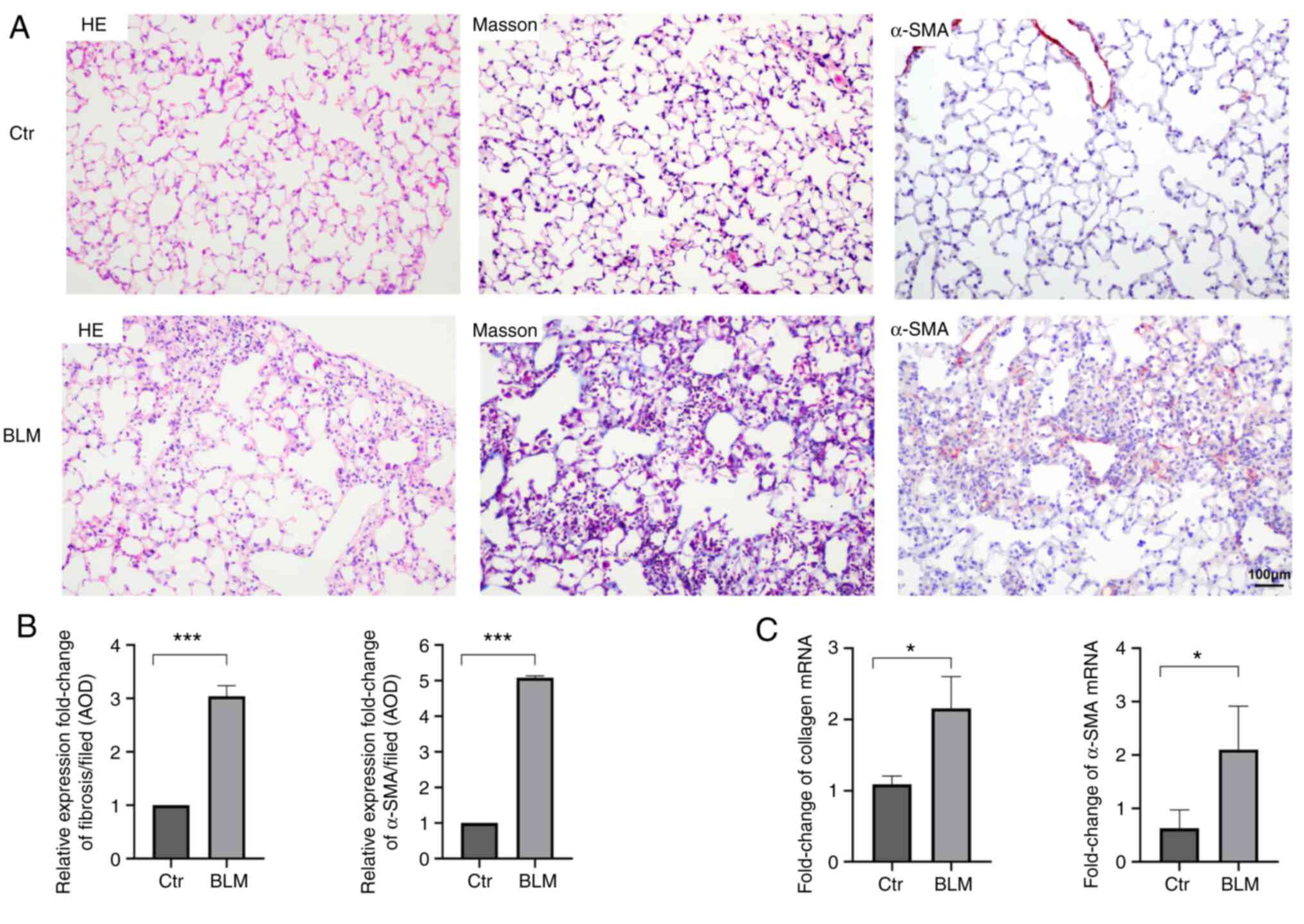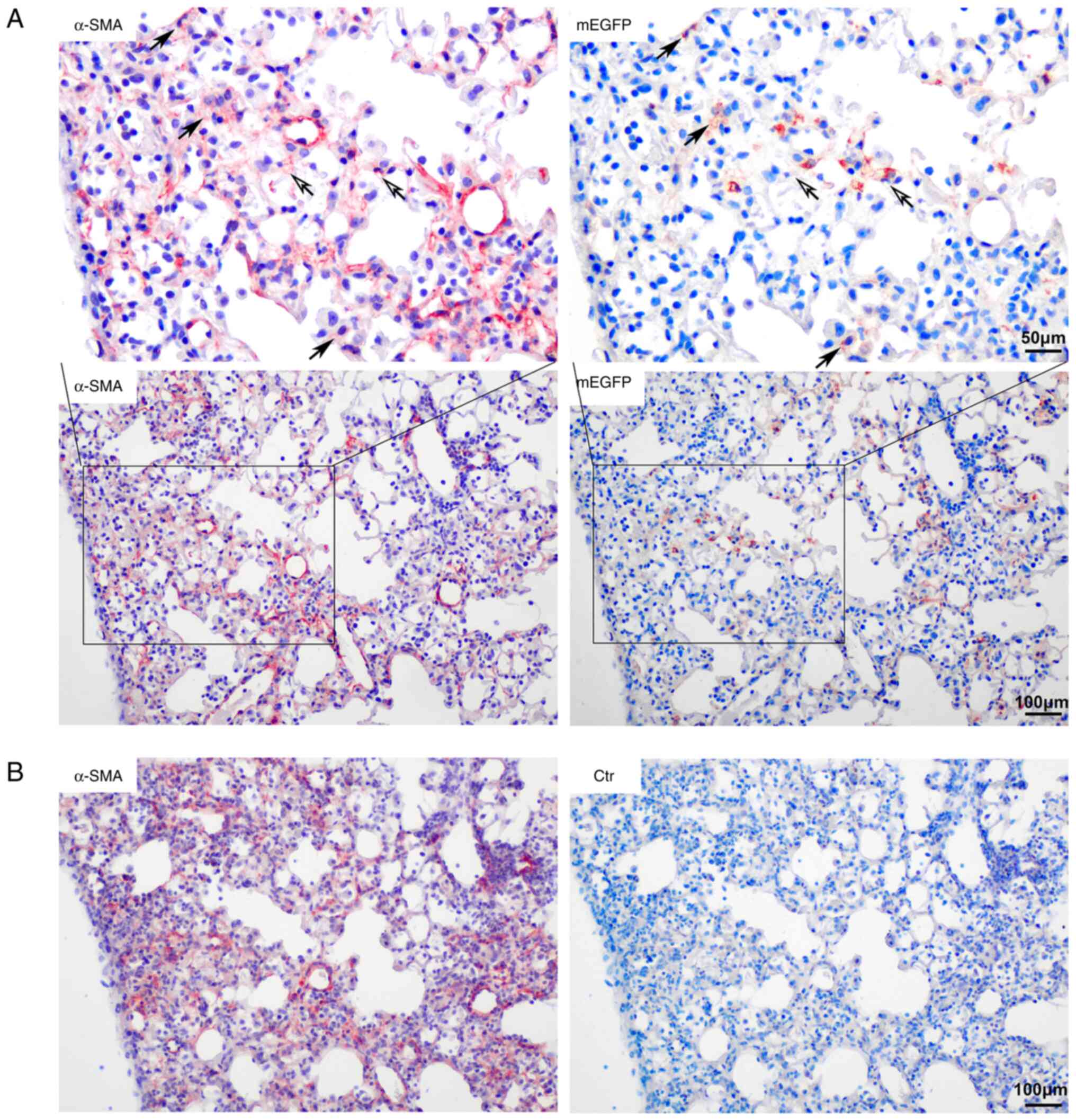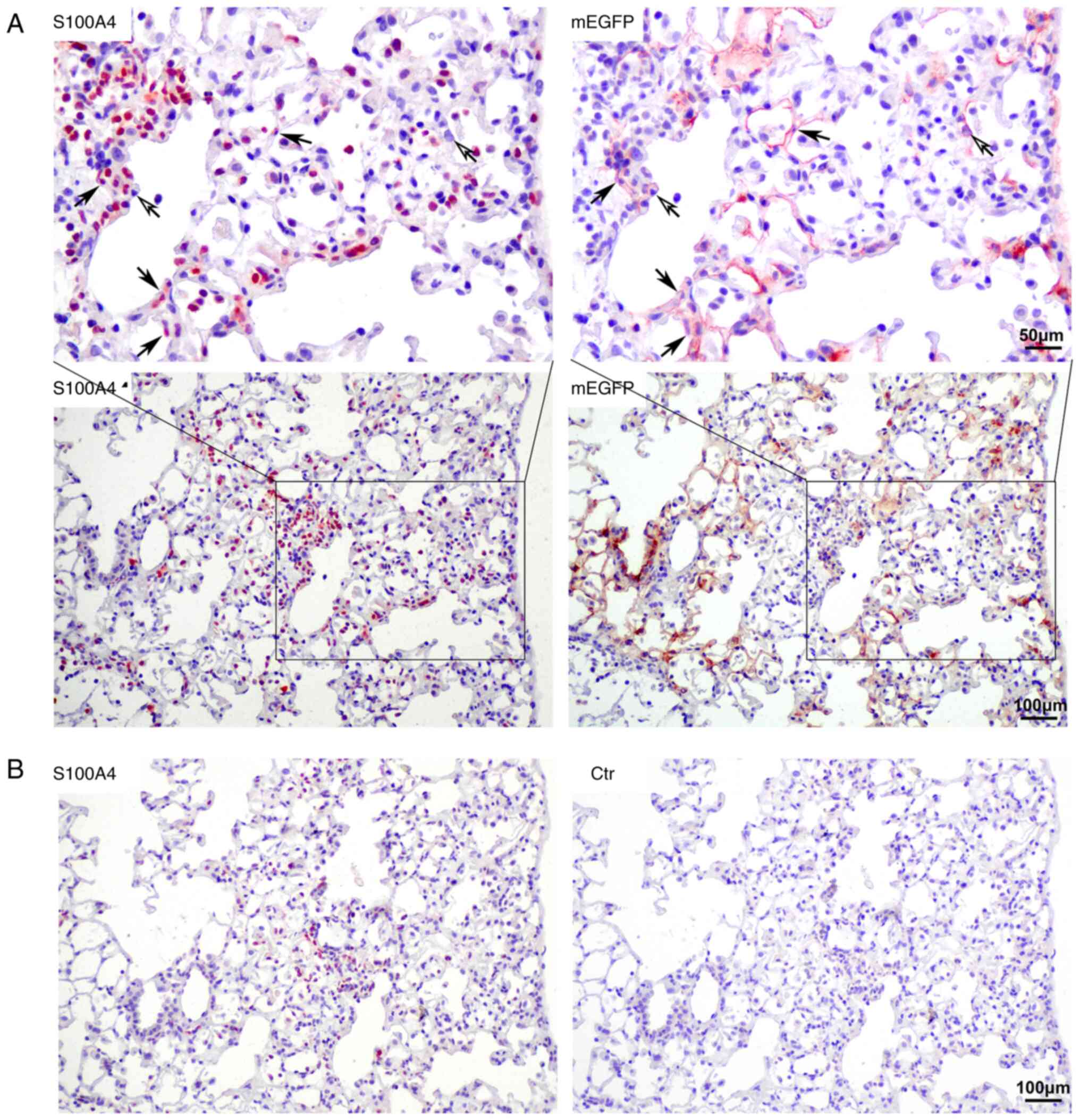|
1
|
Barratt SL, Creamer A, Hayton C and
Chaudhuri N: Idiopathic pulmonary fibrosis (IPF): An overview. J
Clin Med. 7(201)2018.PubMed/NCBI View Article : Google Scholar
|
|
2
|
Raghu G, Remy-Jardin M, Myers JL, Richeldi
L, Ryerson CJ, Lederer DJ, Behr J, Cottin V, Danoff SK, Morell F,
et al: Diagnosis of idiopathic pulmonary fibrosis. An official
ATS/ERS/JRS/ALAT clinical practice guideline. Am J Respir Crit Care
Med. 198:e44–e68. 2018.PubMed/NCBI View Article : Google Scholar
|
|
3
|
Richeldi L, Collard HR and Jones MG:
Idiopathic pulmonary fibrosis. Lancet. 389:1941–1952.
2017.PubMed/NCBI View Article : Google Scholar
|
|
4
|
Moeller A, Gilpin SE, Ask K, Cox G, Cook
D, Gauldie J, Margetts PJ, Farkas L, Dobranowski J, Boylan C, et
al: Circulating fibrocytes are an indicator of poor prognosis in
idiopathic pulmonary fibrosis. Am J Respir Crit Care Med.
179:588–594. 2009.PubMed/NCBI View Article : Google Scholar
|
|
5
|
Selman M and Pardo A: The leading role of
epithelial cells in the pathogenesis of idiopathic pulmonary
fibrosis. Cell Signal. 66(109482)2020.PubMed/NCBI View Article : Google Scholar
|
|
6
|
Nieto MA, Huang RY, Jackson RA and Thiery
JP: EMT: 2016. Cell. 166:21–45. 2016.PubMed/NCBI View Article : Google Scholar
|
|
7
|
Salton F, Ruaro B, Confalonieri P and
Confalonieri M: Epithelial-mesenchymal transition: A major
pathogenic driver in idiopathic pulmonary fibrosis? Medicina
(Kaunas). 56(608)2020.PubMed/NCBI View Article : Google Scholar
|
|
8
|
Salton F, Volpe MC and Confalonieri M:
Epithelial-mesenchymal transition in the pathogenesis of idiopathic
pulmonary fibrosis. Medicina (Kaunas). 55(83)2019.PubMed/NCBI View Article : Google Scholar
|
|
9
|
Kim KK, Kugler MC, Wolters PJ, Robillard
L, Galvez MG, Brumwell AN, Sheppard D and Chapman HA: Alveolar
epithelial cell mesenchymal transition develops in vivo during
pulmonary fibrosis and is regulated by the extracellular matrix.
Proc Natl Acad Sci USA. 103:13180–13185. 2006.PubMed/NCBI View Article : Google Scholar
|
|
10
|
DeMaio L, Buckley ST, Krishnaveni MS,
Flodby P, Dubourd M, Banfalvi A, Xing Y, Ehrhardt C, Minoo P, Zhou
B, et al: Ligand-independent transforming growth factor-β type I
receptor signalling mediates type I collagen-induced
epithelial-mesenchymal transition. J Pathol. 226:633–644.
2012.PubMed/NCBI View Article : Google Scholar
|
|
11
|
Kim KK, Wei Y, Szekeres C, Kugler MC,
Wolters PJ, Hill ML, Frank JA, Brumwell AN, Wheeler SE, Kreidberg
JA and Chapman HA: Epithelial cell alpha3beta1 integrin links
beta-catenin and Smad signaling to promote myofibroblast formation
and pulmonary fibrosis. J Clin Invest. 119:213–224. 2009.PubMed/NCBI View
Article : Google Scholar
|
|
12
|
Tanjore H, Xu XC, Polosukhin VV, Degryse
AL, Li B, Han W, Sherrill TP, Plieth D, Neilson EG, Blackwell TS
and Lawson WE: Contribution of epithelial-derived fibroblasts to
bleomycin-induced lung fibrosis. Am J Respir Crit Care Med.
180:657–665. 2009.PubMed/NCBI View Article : Google Scholar
|
|
13
|
Degryse AL, Tanjore H, Xu XC, Polosukhin
VV, Jones BR, McMahon FB, Gleaves LA, Blackwell TS and Lawson WE:
Repetitive intratracheal bleomycin models several features of
idiopathic pulmonary fibrosis. Am J Physiol Lung Cell Mol Physiol.
299:L442–L452. 2010.PubMed/NCBI View Article : Google Scholar
|
|
14
|
Degryse AL, Tanjore H, Xu XC, Polosukhin
VV, Jones BR, Boomershine CS, Ortiz C, Sherrill TP, McMahon FB,
Gleaves LA, et al: TGFβ signaling in lung epithelium regulates
bleomycin-induced alveolar injury and fibroblast recruitment. Am J
Physiol Lung Cell Mol Physiol. 300:L887–L897. 2011.PubMed/NCBI View Article : Google Scholar
|
|
15
|
Rock JR, Barkauskas CE, Cronce MJ, Xue Y,
Harris JR, Liang J, Noble PW and Hogan BL: Multiple stromal
populations contribute to pulmonary fibrosis without evidence for
epithelial to mesenchymal transition. Proc Natl Acad Sci USA.
108:E1475–E1483. 2011.PubMed/NCBI View Article : Google Scholar
|
|
16
|
Chilosi M, Caliò A, Rossi A, Gilioli E,
Pedica F, Montagna L, Pedron S, Confalonieri M, Doglioni C, Ziesche
R, et al: Epithelial to mesenchymal transition-related proteins
ZEB1, β-catenin, and β-tubulin-III in idiopathic pulmonary
fibrosis. Mod Pathol. 30:26–38. 2017.PubMed/NCBI View Article : Google Scholar
|
|
17
|
Harada T, Nabeshima K, Hamasaki M, Uesugi
N, Watanabe K and Iwasaki H: Epithelial-mesenchymal transition in
human lungs with usual interstitial pneumonia: Quantitative
immunohistochemistry. Pathol Int. 60:14–21. 2010.PubMed/NCBI View Article : Google Scholar
|
|
18
|
Livak KJ and Schmittgen TD: Analysis of
relative gene expression data using real-time quantitative PCR and
the 2(-Delta Delta C(T)) method. Methods. 25:402–408.
2001.PubMed/NCBI View Article : Google Scholar
|
|
19
|
Boye K and Maelandsmo GM: S100A4 and
metastasis: A small actor playing many roles. Am J Pathol.
176:528–535. 2010.PubMed/NCBI View Article : Google Scholar
|
|
20
|
B Moore B, Lawson WE, Oury TD, Sisson TH,
Raghavendran K and Hogaboam CM: Animal models of fibrotic lung
disease. Am J Respir Cell Mol Biol. 49:167–179. 2013.PubMed/NCBI View Article : Google Scholar
|
|
21
|
Mouratis MA and Aidinis V: Modeling
pulmonary fibrosis with bleomycin. Curr Opin Pulm Med. 17:355–361.
2011.PubMed/NCBI View Article : Google Scholar
|
|
22
|
Moore BB and Hogaboam CM: Murine models of
pulmonary fibrosis. Am J Physiol Lung Cell Mol Physiol.
294:L152–L160. 2008.PubMed/NCBI View Article : Google Scholar
|
|
23
|
Degryse AL and Lawson WE: Progress toward
improving animal models for idiopathic pulmonary fibrosis. Am J Med
Sci. 341:444–449. 2011.PubMed/NCBI View Article : Google Scholar
|
|
24
|
Lawson WE, Polosukhin VV, Stathopoulos GT,
Zoia O, Han W, Lane KB, Li B, Donnelly EF, Holburn GE, Lewis KG, et
al: Increased and prolonged pulmonary fibrosis in surfactant
protein C-deficient mice following intratracheal bleomycin. Am J
Pathol. 167:1267–1277. 2005.PubMed/NCBI View Article : Google Scholar
|
|
25
|
Adamson IY and Bowden DH: The pathogenesis
of bloemycin-induced pulmonary fibrosis in mice. Am J Pathol.
77:185–197. 1974.PubMed/NCBI
|
|
26
|
Yoldas O, Karaca T, Bilgin BC, Yilmaz OH,
Simsek GG, Alici IO, Uzdogan A, Karaca N, Akin T, Yoldas S and
Akbiyik F: Tamoxifen citrate: A glimmer of hope for silicosis. J
Surg Res. 193:429–434. 2015.PubMed/NCBI View Article : Google Scholar
|
|
27
|
El Agha E, Moiseenko A, Kheirollahi V, De
Langhe S, Crnkovic S, Kwapiszewska G, Szibor M, Kosanovic D,
Schwind F, Schermuly RT, et al: Two-way conversion between
lipogenic and myogenic fibroblastic phenotypes marks the
progression and resolution of lung fibrosis. Cell Stem Cell.
20:261–273.e3. 2017.PubMed/NCBI View Article : Google Scholar
|
|
28
|
Perl AK, Wert SE, Nagy A, Lobe CG and
Whitsett JA: Early restriction of peripheral and proximal cell
lineages during formation of the lung. Proc Natl Acad Sci USA.
99:10482–10487. 2002.PubMed/NCBI View Article : Google Scholar
|
|
29
|
Schafer MJ, White TA, Iijima K, Haak AJ,
Ligresti G, Atkinson EJ, Oberg AL, Birch J, Salmonowicz H, Zhu Y,
et al: Cellular senescence mediates fibrotic pulmonary disease. Nat
Commun. 8(14532)2017.PubMed/NCBI View Article : Google Scholar
|
|
30
|
Chen X, Xu H, Hou J, Wang H, Zheng Y, Li
H, Cai H, Han X and Dai J: Epithelial cell senescence induces
pulmonary fibrosis through Nanog-mediated fibroblast activation.
Aging (Albany NY). 12:242–259. 2019.PubMed/NCBI View Article : Google Scholar
|
|
31
|
Pirici D, Mogoanta L, Kumar-Singh S,
Pirici I, Margaritescu C, Simionescu C and Stanescu R: Antibody
elution method for multiple immunohistochemistry on primary
antibodies raised in the same species and of the same subtype. J
Histochem Cytochem. 57:567–575. 2009.PubMed/NCBI View Article : Google Scholar
|
|
32
|
Bolognesi MM, Manzoni M, Scalia CR,
Zannella S, Bosisio FM, Faretta M and Cattoretti G: Multiplex
staining by sequential immunostaining and antibody removal on
routine tissue sections. J Histochem Cytochem. 65:431–444.
2017.PubMed/NCBI View Article : Google Scholar
|
|
33
|
Borensztajn K, Crestani B and Kolb M:
Idiopathic pulmonary fibrosis: From epithelial injury to
biomarkers-insights from the bench side. Respiration. 86:441–452.
2013.PubMed/NCBI View Article : Google Scholar
|
|
34
|
Bagnato G and Harari S: Cellular
interactions in the pathogenesis of interstitial lung diseases. Eur
Respir Rev. 24:102–114. 2015.PubMed/NCBI View Article : Google Scholar
|
|
35
|
Yamaguchi M, Hirai S, Tanaka Y, Sumi T,
Miyajima M, Mishina T, Yamada G, Otsuka M, Hasegawa T, Kojima T, et
al: Fibroblastic foci, covered with alveolar epithelia exhibiting
epithelial-mesenchymal transition, destroy alveolar septa by
disrupting blood flow in idiopathic pulmonary fibrosis. Lab Invest.
97:232–242. 2017.PubMed/NCBI View Article : Google Scholar
|
|
36
|
Xia H, Gilbertsen A, Herrera J, Racila E,
Smith K, Peterson M, Griffin T, Benyumov A, Yang L, Bitterman PB
and Henke CA: Calcium-binding protein S100A4 confers mesenchymal
progenitor cell fibrogenicity in idiopathic pulmonary fibrosis. J
Clin Invest. 127:2586–2597. 2017.PubMed/NCBI View Article : Google Scholar
|
|
37
|
Lee JU, Chang HS, Shim EY, Park JS, Koh
ES, Shin HK, Park JS and Park CS: The S100 calcium-binding protein
A4 level is elevated in the lungs of patients with idiopathic
pulmonary fibrosis. Respir Med. 171(105945)2020.PubMed/NCBI View Article : Google Scholar
|


















